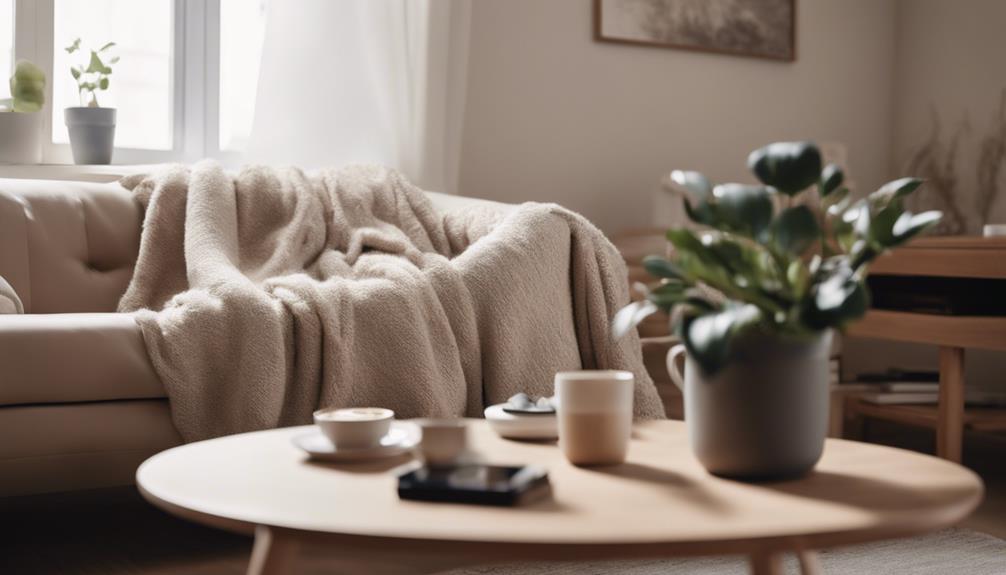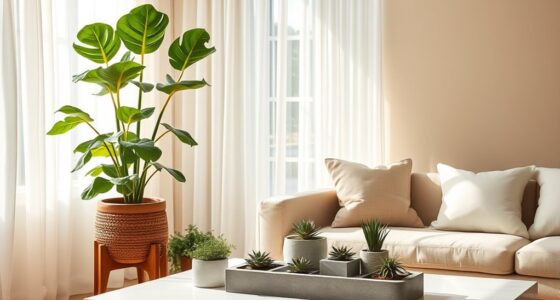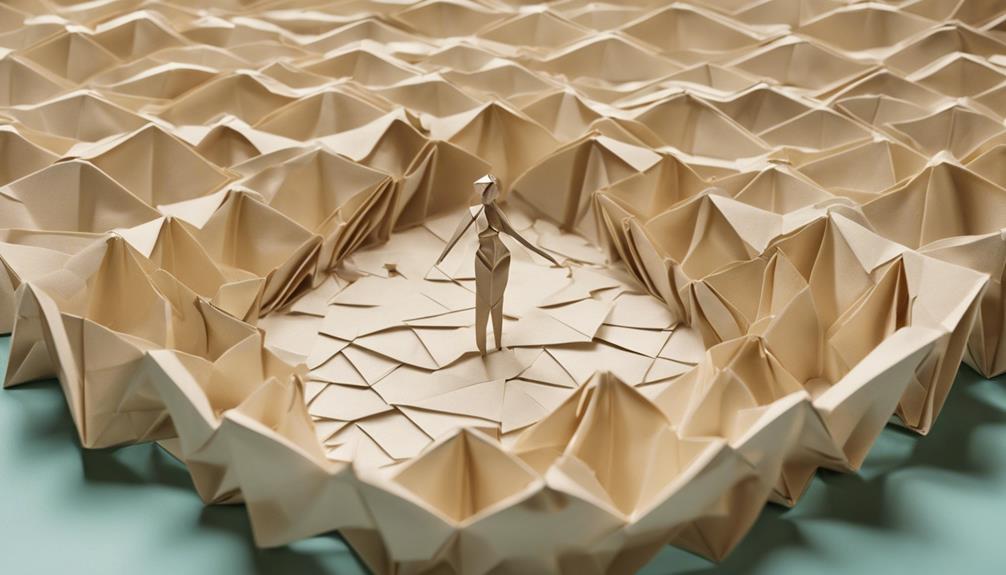You can achieve a warm Scandinavian atmosphere while embracing minimalism by focusing on natural materials and a neutral color palette. Use soft textiles, like chunky knit blankets and plush cushions, to create comfort without clutter. Choose essential furniture that combines functionality and simple designs, such as wooden coffee tables and lounge chairs. Soft lighting, like warm LED string lights and natural wood floor lamps, enhances coziness without overwhelming the space. Add touchpoints of nature through decorative elements like ceramic vases with wildflowers or handwoven wall hangings. Stick around, and you'll discover more tips to refine your cozy minimalist setup.
Key Elements
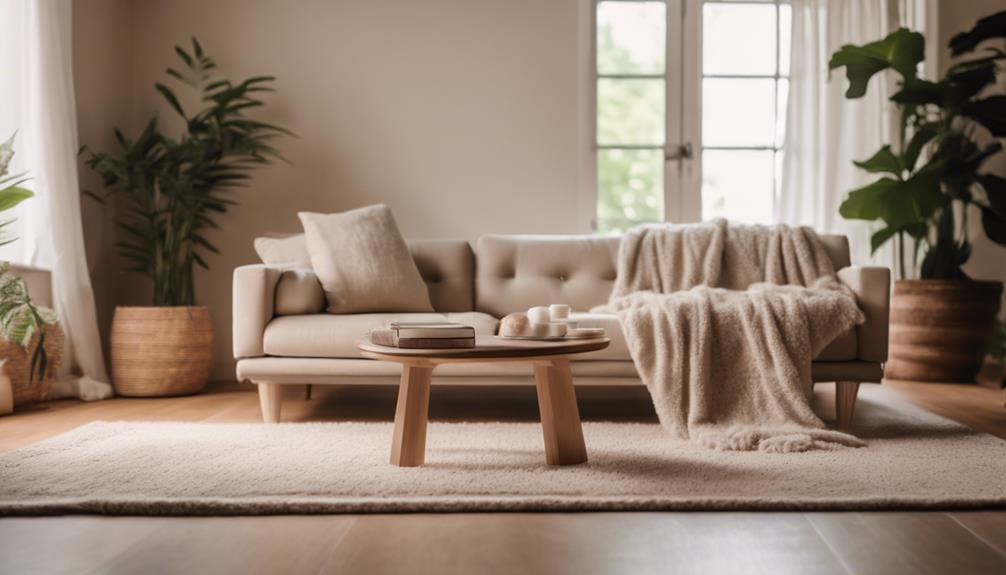
When you think about Scandinavian coziness, start with the color scheme—neutral tones set the perfect foundation.
Next, consider the materials and textures; using natural elements adds warmth while keeping things minimalist.
Color Scheme
A Scandinavian color scheme combines a neutral palette of whites, grays, and earth tones to create a serene atmosphere that feels both calming and inviting. This color scheme is vital in achieving the cozy feel associated with Scandinavian design while maintaining minimalism.
You can introduce accent colors, like muted pastels or deep jewel tones, to add warmth and depth without compromising the clean aesthetic.
Utilizing natural materials, such as wood and stone, enhances the overall ambiance, reinforcing the cozy vibe.
To further this inviting atmosphere, focus on soft, ambient lighting. Warm white bulbs, candles, and fairy lights play a significant role in creating a welcoming environment, perfect for relaxation or socializing.
Materials
Scandinavian design thrives on natural materials like wood, wool, and linen, which bring warmth and texture to minimalist spaces. By incorporating these natural materials, you create a cozy home that feels inviting yet maintains a clean aesthetic. Soft textiles, such as chunky knit blankets and plush cushions, add layers of comfort without overwhelming your decor, keeping in line with the principles of minimalism.
To enhance the ambiance, consider integrating ambient lighting through candles, fairy lights, or soft lamps. This not only creates a cozy atmosphere but also aligns with the Scandinavian style of simplicity and functionality. A neutral color palette featuring whites, grays, and earth tones further promotes tranquility, allowing your materials to shine while maintaining a serene environment.
Lastly, focus on functional decor. Select items that serve a purpose—like potted plants that improve air quality and add visual interest—ensuring your space feels intentional and uncluttered. By thoughtfully choosing materials and decor, you can achieve that perfect blend of Scandinavian coziness and minimalism, creating a warm and inviting space that remains effortlessly stylish.
Textures
Textures play an essential role in achieving that cozy yet minimalist aesthetic, inviting warmth and comfort into your space. To enhance your Scandinavian-inspired design, incorporate cozy textiles like chunky knit blankets and soft wool throws. These elements provide warmth without overcrowding your minimalist decor.
Opt for soft fabrics such as linen and cotton in neutral colors, which promote a serene atmosphere while adhering to Scandinavian design principles. Layering textures is key—mix smooth wood surfaces with plush cushions or rugs to create visual interest without excessive decorative elements.
Don't forget about natural materials. Using jute or sisal rugs adds a tactile quality, reinforcing that cozy ambiance while keeping your space uncluttered.
Ambient lighting is another crucial aspect. Textured lampshades or candle holders can cast a warm, welcoming glow that enhances the cozy feel, creating inviting corners in your home.
Essential Fixtures and Furniture
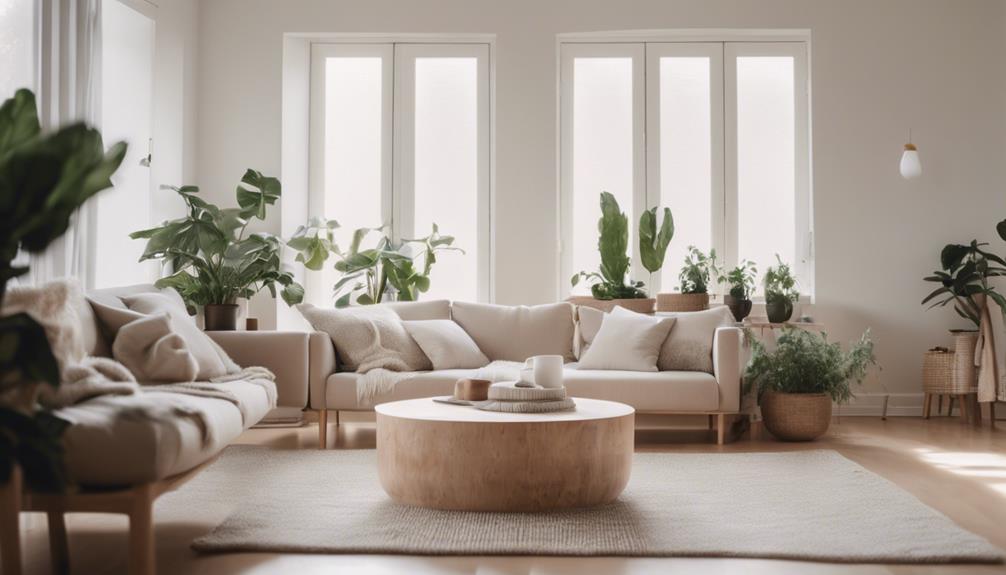
When you think about essential fixtures and furniture in Scandinavian design, consider pieces like a wooden coffee table, a lounge chair, and a pendant light.
Each item plays a crucial role in creating a cozy yet minimalist atmosphere that invites relaxation.
Scandinavian-Style Wooden Coffee Table
A wooden coffee table in the Scandinavian style brings a harmonious blend of functionality and minimalist design to your living space. Often crafted from natural materials like oak or birch, these tables enhance warmth and simplicity while fitting seamlessly into your decor.
With clean lines and neutral color palettes, they promote a sense of openness and brightness, contributing to a cozy atmosphere.
Scandinavian-style coffee tables emphasize functionality by incorporating clever storage options like drawers or shelves. This helps you maintain a clutter-free environment, allowing the table to serve as a focal point in your living area.
Their low profile encourages relaxed seating arrangements, creating an inviting space for social interactions.
Moreover, the minimalist design of these coffee tables guarantees they remain versatile, blending harmoniously with various styles while highlighting the beauty of simplicity.
When you choose a Scandinavian coffee table, you not only invest in a piece of furniture but also in a lifestyle that embraces both coziness and minimalism. This balance is essential for achieving a warm, welcoming home without sacrificing your commitment to a clean and uncluttered aesthetic.
Scandinavian-Style Lounge Chair
Scandinavian-style lounge chairs seamlessly blend comfort and minimalist design, making them essential fixtures that elevate any living space. These chairs embody the 'less is more' philosophy, featuring clean lines and functional aesthetics. With ergonomic shapes and soft upholstery, they're cozy and comfortable, encouraging you to unwind and relax after a long day.
Opt for iconic designs like the Hans Wegner Wishbone Chair or the Eero Saarinen Womb Chair, both of which showcase timeless style while prioritizing comfort. Their streamlined silhouettes fit perfectly into minimalist spaces, enhancing the overall aesthetic without creating visual clutter.
When choosing a lounge chair, consider muted color palettes such as soft grays, whites, and earth tones. These hues create a soothing atmosphere that complements other decor elements, allowing your lounge chair to shine as a focal point of coziness.
Incorporating a Scandinavian-style lounge chair into your living room provides a dedicated spot for relaxation, reading, or socializing. By prioritizing comfort without sacrificing minimalism, you can achieve a stylish and inviting living space that truly embodies Scandinavian coziness.
Scandinavian-Style Pendant Light
Emphasizing clean lines and minimalist design, pendant lights enhance your space with a warm, inviting atmosphere.
Scandinavian-style pendant lights are perfect for achieving this balance, featuring simple shapes and geometric forms that complement your decor without overwhelming it. Their use of natural materials, like wood or metal, adds an organic touch that aligns with the principles of minimalism.
These fixtures typically incorporate soft, diffused lighting, fostering a cozy ambiance ideal for dining areas and living spaces. You can easily adjust their height, allowing for versatility across various room sizes and ceiling heights. This adaptability guarantees that your lighting works harmoniously within your home.
One iconic option is the PH lamp, designed by Poul Henningsen. Its layered shades effectively control light distribution while maintaining a sleek profile, making it a stylish choice for any minimalist setting.
By selecting Scandinavian-style pendant lights, you're not just illuminating your space; you're creating a serene environment that embodies both coziness and simplicity.
Lighting Ideas
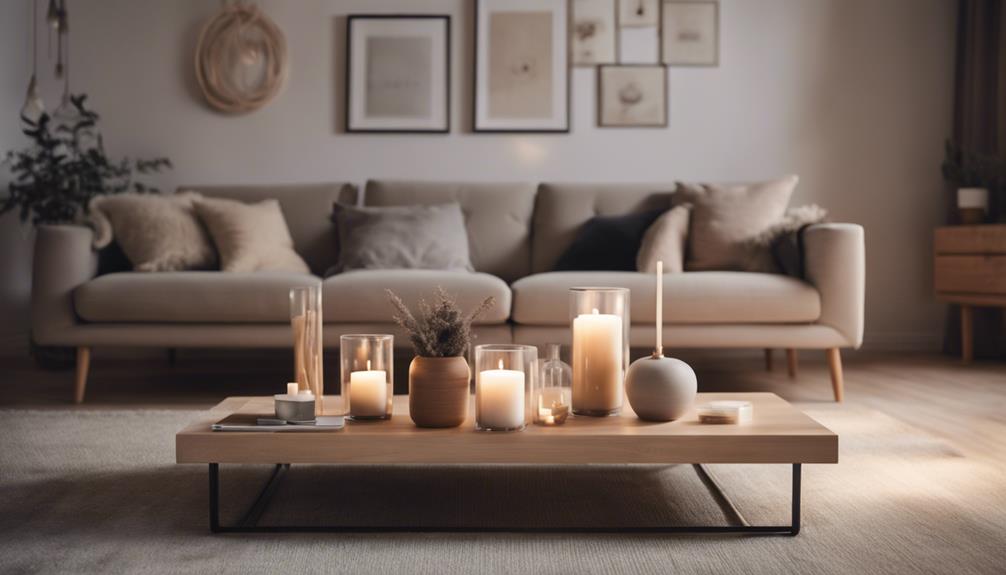
When it comes to lighting, you'll want to embrace simplicity and warmth.
Consider incorporating a soft pendant light fixture or warm LED string lights to create that cozy vibe.
Natural wood floor lamps and Scandinavian wall sconces can also enhance your space while keeping the minimalist aesthetic intact.
Soft Pendant Light Fixture
Soft pendant light fixtures often transform a space, providing that essential ambient glow while embracing the simplicity of minimalism.
In Scandinavian design, these fixtures are vital for creating a cozy atmosphere without overwhelming your decor. Opt for a soft pendant light fixture made from natural materials, like wood or fabric, to align with sustainable principles while adding warmth.
Dimmable lights are another great choice, enabling you to adjust the brightness and craft a tranquil environment that supports relaxation and comfort.
When selecting your fixture, look for one with a neutral color palette—think whites or soft grays—to guarantee it blends seamlessly into your minimalist aesthetic while still imparting character.
Warm LED String Lights
Warm LED string lights bring an inviting glow to your space, perfectly complementing the soft pendant light fixtures that set the stage for Scandinavian coziness. These energy-efficient lights use up to 90% less energy than traditional incandescent bulbs, making them a sustainable choice for creating a cozy atmosphere. Their soft illumination mimics the warmth of candlelight, enhancing the Hygge ambiance essential for a relaxing environment.
Available in various designs, including fairy lights and globe bulbs, warm LED string lights seamlessly integrate into minimalist decor without overwhelming your space. You can drape them over furniture or along walls to add visual interest and warmth, promoting that comfortable vibe synonymous with Scandinavian living.
Many options come with adjustable brightness settings and timers, allowing you to customize the lighting to elevate your mood while keeping the design simple. Whether you're hosting friends or enjoying a quiet evening alone, these lights help you achieve a cozy atmosphere that feels both inviting and stylish.
Embrace the charm of warm LED string lights to enhance your home and maintain that perfect balance between coziness and minimalism.
Natural Wood Floor Lamp
Enhancing your space with a natural wood floor lamp instantly brings warmth and character to your minimalist decor. This lamp not only elevates the aesthetic of your minimalist home but also utilizes sustainable materials, promoting an eco-friendly environment. The warm ambient glow it provides creates a cozy atmosphere synonymous with Scandinavian hygge, making your space feel inviting and comfortable.
When choosing a natural wood floor lamp, look for one with adjustable brightness settings. This feature allows you to customize the lighting to suit your activities, whether you're reading a book or winding down for the evening. A lamp with a simple, clean design aligns with Scandinavian principles, emphasizing functionality and beauty without unnecessary embellishments.
Incorporating a natural wood floor lamp can serve as a focal point in your room, adding warmth and texture while maintaining a clutter-free decor. Its presence not only enhances the overall ambiance but also reflects your commitment to sustainable living.
Embrace the perfect blend of style and practicality with a natural wood floor lamp, and transform your space into a haven of coziness and minimalism.
Scandinavian Wall Sconce Lighting
Discover how Scandinavian wall sconces can elevate your home's ambiance while maintaining a sleek, minimalist aesthetic. These fixtures often feature clean lines and are crafted from natural materials like wood and metal, making them blend seamlessly into modern interiors. By choosing wall sconces, you can create a cozy atmosphere without sacrificing style.
Many Scandinavian sconces come with adjustable features, allowing you to customize lighting angles and intensities. This flexibility is perfect for achieving that hygge vibe, where warm-toned LED bulbs cast a soft, inviting glow throughout your space. The focus on simplicity and practicality in Scandinavian design means you'll find styles ranging from sleek geometric shapes to organic forms that reflect nature.
Incorporating wall sconces into your decor can help declutter surfaces, providing ambient lighting while keeping your space open and airy. By strategically placing these minimalist fixtures, you not only enhance your home's aesthetic but also create a warm, inviting environment that feels both cozy and sophisticated.
Embrace Scandinavian wall sconces to elevate your lighting game while staying true to a minimalist vision.
Decorative Elements
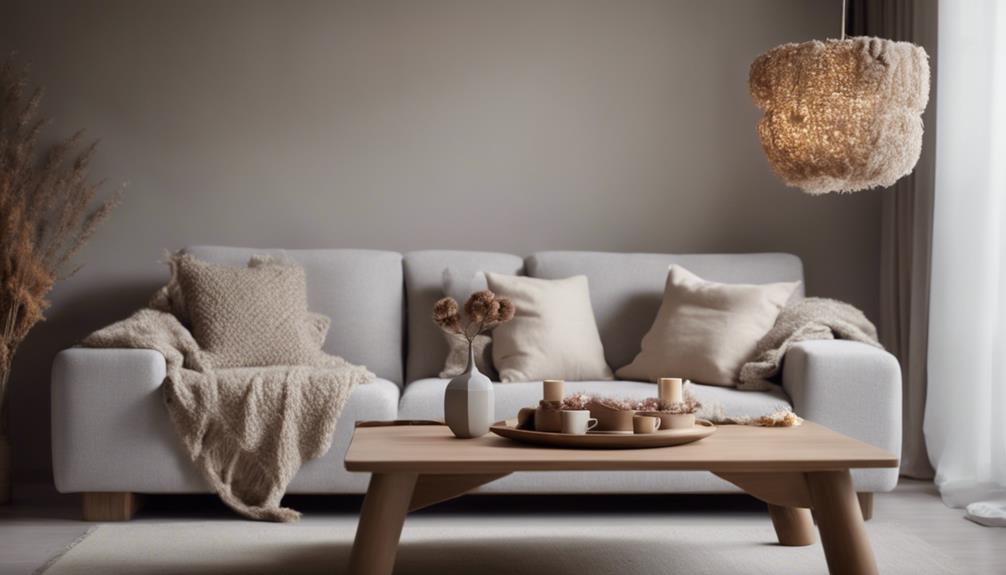
When you think about decorative elements in Scandinavian design, consider how simple touches can enhance your space.
A ceramic vase filled with wildflowers, a handwoven wool wall hanging, or a rustic wooden bowl can all add character without cluttering your minimalist aesthetic.
These pieces not only serve as decor but also connect you to the natural beauty and coziness that define Scandinavian style.
Ceramic Vase With Wildflowers
A ceramic vase filled with wildflowers can instantly brighten your minimalist Scandinavian decor, bringing a touch of nature into your home. By choosing a simple, clean-lined ceramic vase, you reflect the core principles of Scandinavian design—functionality and beauty—while keeping your space clutter-free.
Wildflowers, known for their low maintenance, enhance the hygge atmosphere, fostering tranquility and warmth. Their vibrant colors stand out beautifully against a neutral-colored vase, complementing the serene palettes typical of Scandinavian decor. This balance allows the wildflowers to serve as the primary decorative element without overwhelming your minimalist aesthetic.
Switching out wildflowers seasonally can create a dynamic ambiance, celebrating nature's beauty and keeping your decor fresh. Whether you opt for vibrant blooms in spring or muted tones in autumn, each arrangement adds a layer of comfort and connection to the outdoors.
Incorporating a ceramic vase with wildflowers into your home not only elevates your decor but also invites the calming essence of nature inside. Embrace this simple yet impactful decorative choice to achieve the cozy, minimalist Scandinavian vibe you desire.
Handwoven Wool Wall Hanging
Incorporating a handwoven wool wall hanging into your decor complements the warmth of wildflowers while adding a unique textural element that enhances your Scandinavian aesthetic.
These wall hangings are a hallmark of Scandinavian design, known for their ability to introduce cozy warmth without cluttering your minimalist space. Their natural, muted colors align seamlessly with the Scandinavian aesthetic, creating an inviting atmosphere that feels both comfortable and stylish.
Wool is an excellent choice for these wall hangings, as it regulates temperature and sound, making your living environment more pleasant.
You'll find that handwoven pieces often feature geometric patterns or organic shapes, serving as focal points that draw the eye while adhering to the minimalist principle of 'less is more.'
Rustic Wooden Bowl Centerpiece
Rustic wooden bowls serve as striking centerpieces that enhance the warmth and natural beauty of your minimalist decor. These bowls bring a cozy aesthetic to any minimalist space, offering a perfect balance between functionality and style. Opting for a rustic wooden bowl made from reclaimed wood not only elevates your design but also promotes sustainability, aligning with an eco-conscious lifestyle.
You can use your bowl to hold seasonal decor items like pinecones or dried flowers, making it easy to refresh your space while maintaining a minimalist approach. Placing the bowl on a neutral-colored table or shelf helps it stand out, creating a curated display that remains clean and uncluttered.
Incorporating a rustic wooden bowl into your decor adds a natural element that enhances the hygge atmosphere in your home. It invites tactile engagement and a sense of connection to nature, perfect for creating a warm, inviting environment.
Whether it's a gathering with friends or a quiet evening at home, a rustic wooden bowl can be the finishing touch that ties your cozy, minimalist decor together beautifully.
Flooring

When it comes to flooring in your Scandinavian-inspired space, light-colored hardwood can enhance the airy feel you're aiming for.
Pairing it with a textured area rug adds warmth without cluttering the minimalist aesthetic.
If you're looking for extra comfort, cork flooring provides a cozy touch while keeping things sleek.
Light-Colored Hardwood Flooring
Enhancing your space with light-colored hardwood flooring not only brightens the room but also embodies the essence of Scandinavian design. Choosing materials like ash or maple amplifies natural light, making your home feel more spacious and inviting. This style creates a cozy atmosphere while maintaining a minimalist aesthetic, perfectly aligning with the simplicity and functionality of Scandinavian decor.
Light-colored hardwood flooring works seamlessly with neutral color palettes, allowing you to incorporate cozy textiles and decorative elements without overwhelming your space. Plus, it's practical; lighter woods tend to show less dust and scratches, helping you maintain a clean, clutter-free environment.
Sustainability is another significant advantage; many options for light hardwood come from responsibly sourced forests, supporting eco-friendly practices. By choosing these materials, you contribute to a harmonious balance in your minimalist home while embracing the principles of Scandinavian design.
Incorporating light-colored hardwood flooring into your space not only elevates its beauty but also fosters a sense of calm and comfort, essential for achieving that Scandinavian coziness you desire without sacrificing minimalism.
Textured Area Rug
A textured area rug adds warmth and comfort to your Scandinavian-inspired space, creating an inviting atmosphere that balances minimalism with coziness. To maintain the minimalist aesthetic, choose rugs in neutral tones or soft colors. This way, you'll introduce visual interest and depth to your flooring without overwhelming the room.
Textured area rugs can help define spaces within multifunctional rooms, offering a sense of separation that eliminates the need for additional furniture. Consider the use of layered rugs; placing a smaller patterned rug over a larger, solid-colored one enhances the cozy atmosphere while remaining true to minimalist principles. This technique not only adds charm but also provides depth to your flooring.
Remember that regular maintenance is key to keeping your area rugs functional and appealing. Vacuuming and spot cleaning will guarantee they stay in great shape and continue to contribute to the overall cozy vibe of your home.
Cork Flooring for Warmth
Cork flooring offers a warm, eco-friendly solution that perfectly aligns with the cozy yet minimalist aesthetic of Scandinavian interiors. As a sustainable choice made from the bark of cork oak trees, it regenerates after harvesting, making it an ideal option for minimalist homes. With its excellent thermal insulation, cork flooring helps maintain a comfy atmosphere, especially during those chilly months.
You'll appreciate how cork feels comfortable underfoot, providing cushioning that reduces fatigue when standing for long periods. This feature enhances the overall coziness of your living spaces, inviting you to linger longer. Plus, cork is hypoallergenic and resistant to mold and mildew, ensuring a healthier indoor environment that supports your wellness goals.
Cork flooring also comes in various colors and patterns, allowing you to achieve a stylish aesthetic without compromising the simplicity of minimalist design. Whether you prefer a light Scandinavian style or a more dramatic look, cork can seamlessly integrate into your home while adding warmth and character.
Conclusion
By blending Scandinavian coziness with minimalism, you can create a peaceful, inviting space that feels both warm and uncluttered. This combination is perfect for those looking to achieve a sense of serenity and simplicity in their home. With the use of clean lines, neutral colors, and natural materials, a space can undergo a minimalist decor transformation that promotes a sense of calm and well-being. Embracing the principles of Scandinavian coziness and minimalism can turn any room into a tranquil retreat, especially during minimalist decor transformation month.
Focus on key elements like essential fixtures and thoughtful lighting to enhance the atmosphere.
Incorporate simple decorative elements that reflect your style without overcrowding the space.
Choose flooring that complements your design while maintaining a clean look.
Embrace these principles, and you'll achieve a harmonious balance that invites relaxation and joy into your home.
